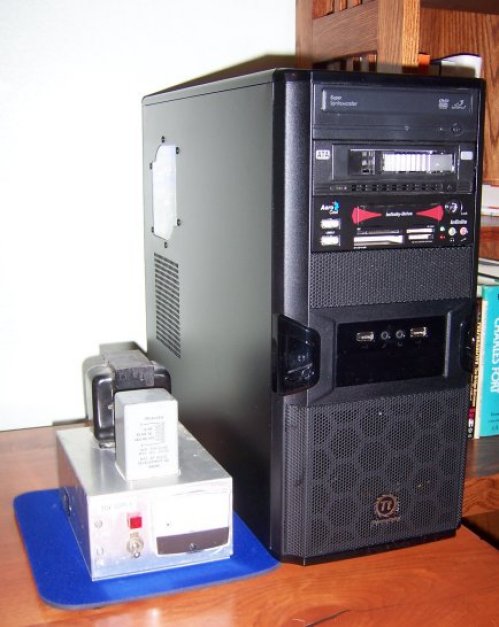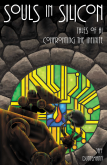- Cisco has sold their Linksys home-router business to Belkin. I’ve used Linksys gear for ten years now, know it well, and like it as much as I like any given brand. Getting it out of Cisco’s hands, where it had languished, is a good thing.
- From a long-time Contra commenter I know only as bcl, here’s a very detailed technical review of USB chargers, which are not all the same based on equal output specs.
- I’m trying to figure out what Ten Gentle Opportunities is “like” (a comp, I think they call it) and have asked those who’ve read the first draft. Someone recommended Piers Anthony’s Apprentice Adept series, which I’ve never seen nor heard of. Will begin looking for copies in local used bookstores.
- IBM is perfecting an anti-microbial gel that they claim bacteria cannot develop resistance to. IBM. God love ’em–because the way things are going, we are gonna need this, and need it bad.
- Then again, IBM also says that Steampunk will be the next big thing. Wait a minute. I thought Steampunk was the last big thing. (Thanks to Bill Cherepy for the link.)
- I’m getting recommendations on surplus dealers I’ve never heard of from all corners. Here’s Twin Cities retailer Ax-Man Surplus, courtesy Lee Hart.
- Lee also passed along the sad news that Glenwood Sales in Rochester NY, where I spent a great deal of money 1979-1984, is no more.
- Pete Albrecht sent word of C&H Surplus in Duarte California. I used to have a print catalog from them and it vanished somewhere along the way, but the firm exists and sells mostly industrial surplus (motors, fans, compressors, etc.)
- I stumbled on a nice free wallpaper site while looking for wood texture images, and there’s a lot of very good stuff there. That said, the single picture they have of a bichon is awful.
- Bill Cherepy sent a link to a Steampunk workspace. Looks cool. As with most Steampunk keyboards, it looks uncomfortable. Love the tube amp, though it’s not really Steampunk. He needs a new (old?) mouse.
- Sex with Neanderthals may have ram-charged our immune system and in other ways made us stronger. Genetic diversity is always good. And I’ll reiterate here that I have serious doubts about Homo Sap wiping out the Neanderthals. I think the Neanderthals wiped themselves out. Tribalism is fatal. Make sure your loyalties are diverse. Never throw poop at other tribes. Throw it at your own tribal leaders. If you can’t do that, well, you’re pwned.
- Cats with jet packs…in 1584. Except I don’t think it’s really a jetpack. Given the bird’s unnecessary jet pack, I suspect that they are acting as living firebombs. The past sucked. I’m glad I’m here.
- We’ve had a so-so winter so far; could use more water coming out of the sky. However, it’s about to get cold again. Perhaps I could use one of these. (Does anybody else flash on H. R. Giger looking at that damned thing?)
- There are certified zombie shotgun shells. Haven’t seen Bigfoot flip-flops yet, though.
electronics
Odd Lots
The Surplus Survivors

I’m trying to clean up the shop a little and free up space, and one of the places I need space the most is in my file cabinet. I’ve been accumulating catalogs for electronic parts and equipment for years untold, and each gets a folder in the top drawer, so that invoices and catalogs can live together. (I want to know what I ordered from who, when. The system works well.)
So I asked myself a week or two ago, How many of these firms are still in business? I began looking them up on the Web. An amazing number are still out there and still selling parts and odd junk like they were back in the 90s. Here is a list of the survivors so far:
- 624 Kits: Now STF Electronics, deals in parts and tube project kits
- A&A Engineering: Now mostly charger kits, some odd parts
- Ace Component Electronics: General small parts surplus
- A. G. Tannenbaum: Vintage radio parts, tubes, old manuals
- All Electronics: General, mostly modern surplus & tools
- Alltronics: General homebrew parts, cases, & tools
- Amidon: Ferrite products, coil forms, baluns, beads, etc.
- Antique Electronic Supply: Tubes, amp parts, NOS stuff.
- BG Micro: General modern small parts surplus
- Burden Sales: Industrial surplus, pumps, fans, motors, clutches
- California Electronic Supply: General surplus
- Dan’s Small Parts: Much RF & ham stuff, great prices
- Debco Electronics: Modern radio-oriented surplus, RF modules, cables
- Electronic Goldmine: General surplus, small parts
- Fair Radio Sales: Military surplus, odd parts & odder grubby stuff
- Far Circuits: PCBs for QST & HR projects, small parts
- Gateway Electronics: Modern surplus, test gear, robot stuff
- Halted Specialties: General modern parts and electronics
- Ham Station: New and used ham gear and odd electronics
- Herbach & Rademan: Motors, mechanical, fans, industrial surplus
- Hosfelt Electronics: General surplus. Online site is hideous.
- Jameco (James Electronics): kits, small parts, test equipment
- JDR Microdevices: Computer surplus, connectors, small parts
- Leeds Radio: Old radio parts, ham radio parts
- Marlin P. Jones: General parts, tools
- MCM Electronics. Audio/visual equipment…and Raspberry Pis!
- Mendelson’s (MECI): Huge, diverse house. Parts, boots, gloves, etc
- Midwest Surplus Electronics: General modern surplus
- Oak Hills Research: W1FB (SK) founder. QRP parts & kits
- Playthings of the Past: Old parts, radio restoration stuff
- Radiokit of Pelham. NH: Still there but not online.
- Radioware: Ham radio antenna stuff, books
- Radio Works: Antennas, antenna parts, wire, baluns
- Ramsey Electronics: Kits, parts, test equipment
- RF Parts: Ham radio parts, tubes, transistors
- Surplus Sales of Nebraska: Most expensive junk in the world
- Tucker Electronics: All test equipment now; few parts
- Weird Stuff Warehouse. Been there. Awesome place. High-tech surplus
There were, of course, some casualties:
- Brigar Electronics, Binghampton NY.
- Burghardt Amateur Center. Still there, but now a repair shop only.
- Classic Radio, Houston.
- DC Electronics, Scottsdale. Sold to Philmore.
- Edlie’s Electronics, Levittown.
- Fertik’s Electronics, Philly. Leon was a character. Appreciation here.
- Ocean State Electronics, RI. Flood apparently did them in.
- Two Fox Electrix, Tivoli, NY
I didn’t list firms that vanished prior to 1990. I used to order lots of stuff from Poly Paks in the 70s, but they’ve been gone a long time. Ditto Tri-Tek, with their embarrassing mascot Amp’l Annie. Nor am I counting the manufacturers’ distributors like Mouser, Digi-Key, and so on. The file drawer has folders for tool vendors, wood products dealers, and non-electronics firms of many sorts, which also had winners and losers that I won’t tally here. (Many of you may know that Small Parts, Inc. has been bought and converted to Amazon Supply.) A number of used book dealers I bought from regularly in the early 1990s are, not surprisingly, gone. One survivor in that category is Bequaert Old Books, which I knew as Rainy Day Books in the early 90s and heartily endorse, especially for old ham books and “boys'” electronics and science books. Frank survived by moving his sales fulfillment to AbeBooks, as the others did not.
The upshot is that the file drawer isn’t a great deal emptier than it was yesterday. I’m good with that, since some of these firms (like Playthings of the Past) are very nearly the sole source for certain items. What I marvel at is how long some of these companies have been around, and how well they’ve weathered our near-constant recession since 2008. The Web helps. Print catalogs and postage are expensive. The good news is that there seems to be enough people like me to float a quirky industry that looks like everybody’s picture of a hoarder’s basement. As grim as these times may be, there’s always something worth celebrating!
Odd Lots
- Dear Abby: God love ya. Go in peace. –Signed, Appreciative.
- Dear Appreciative: He does. And I did.
- An interesting piece in yesterday’s Wall Street Journal indicates that magazine publishers are successfully charging much more for their digital editions than their print editions. Lots more–like, twice the price. It may be the upscale “tablet demographic.” We’ll know as tablets work their way down the food chain.
- Many thought that a silent ride would be one of the great advantages of electric vehicles. Alas, no: People want to hear cars coming, so the National Highway Traffic Safety Administration will eventually force manufacturers to build electronic noise systems into new EVs. The mandated noise makes them sound like internal combustion cars. Better than ice cream trucks, I guess.
- I’ve been testing bottled sangria lately, and after much grueling testing, I declare this one the winner.
- That goofball Kim Dotcom is trying again, and I give him points for balls: He’s opened Mega, a new cloud storage service that might be construed as designed to protect Mega from its customers. As best I can tell, it can work perfectly fine as a file-sharing system, along the same lines as the other bitlockers. It’s distributed, redundant, and entirely outside the United States. An insight: The war on piracy mainly creates better pirates. We’ll see.
- Why do we seem to remember our 20s better than any other period of our lives? First of all, I’m not sure we do. (My clearest memories are of my Coriolis years, from age 37 to age 50.) But if the phenomenon is about the time when we define ourselves, it may simply be that most people define themselves earlier than I did. Or it may all be nonsense.
- Admitting that he used a $5000 metal detector, this guy struck major gold. In eighth grade, I built a $0 metal detector made of parts pried out of dead transistor radios, and my big strike was three chicken bones wrapped in aluminum foil at Illinois Beach State Park. Maybe you really do get what you pay for.
- Of course, if you’re just looking for quarters in the sand, Hammacher Schlemmer’s $60 metal detecting flip-flops may be just the thing. I might have thought of that, but flip-flops barely existed here in 1966.
- Tribal epicosity metafail: Declaring silly little shit an “epic fail” because your tribe disapproves of it.
Odd Lots
- From the “…And Then We Win” Department: Lulu is eliminating DRM on ebooks published through the site. (I was notified by email.)
- The Adobe CS2 download link everybody’s talking about (see my entry for January 10, 2013) is still wide-open. If it was indeed a mistake, you’d think they would have fixed it by now. New suggestion: They’re arguing about it. New hope: They’re really going to allow CS2’s general use without charge.
- I didn’t get the art gene from my mother, but I did indeed enjoy the Museum of Forgotten Art Supplies. I still have my full drafting set in a drawer somewhere, replete with bow compasses, French curves, triangles, and so on. How many years will it be before nobody under 50 has any idea what those are? (Thanks to Jim Rittenhouse for the link.)
- And while we’re doing peculiar museums, check out this selection of implements from the International Spy Museum. I believe the surplus houses were selling CIA turd transmitters twenty or thirty years ago. Shoulda bought one when I could. As the late, great George M. Ewing would have said: “Forget it, Jeff. Nobody will pick that up.”
- Strange transmitters you want? From Bruce Baker comes a video link that no steampunker will want to miss: The annual fire-up of the only Alexanderson alternator left in the world, station SAQ in Sweden. From the sparks to the swinging meter needles, it’s just like Frankenstein, only it’s real–and sends Morse telegraphy at 100 KHz or so. No vacuum tubes, and I don’t see any reason why it couldn’t have been in operation in 1890.
- Every wonder who was behind Information Unlimited? Here’s the guy.
- Here’s more on how fructose messes with your brain. It’s not just the number of calories. It’s the chemical composition of those calories. Whoever says “a calorie is a calorie” is wrong, and probably has an agenda.
- It’s almost pointless to link to the first video ever made of a giant squid (since we won’t see the whole thing until January 27) but Ars Technica has a background page that’s worth reading. “Hello, beastie!”
- The BMI is worse than worthless. But I told you that years ago.
- Brand fanboys may have low self-esteem. Or they may just be tribalists. Or tribalists may be people with low self-esteem. No matter: Defend no brand but your own. Big Brands can damned well defend themselves.
Odd Lots
- I’ve installed Lazarus 1.0 without mayhem, and have created a few simple programs with it. So far, no glitches. My recommendation is still cautious. Nonetheless, I’d be interested in hearing other people’s experiences with the new release.
- Carmine Gallo wonders why more people aren’t doing image-rich PowerPoint presentations. Um…it’s because drawing pictures is way hard compared to writing text. Why is there no mention of this either in the article or in the comments?
- Here’s a great timesaver: Instead of making political posts on Facebook, point to this. Done! Effortless! (Link courtesy S. Hudson Blount.)
- And if that doesn’t work for you, this may. (Link courtesy Jim Mischel.)
- I guess the evidence is piling up: It’s time to stand in front of the bathroom mirror and ask yourself: Does this political opinion make my head look small?
- I’m glad that somebody else besides me noticed that The Atlantic came back from the dead mostly by publishing articles calculated to raise people’s blood pressure. I was a very satisfied subscriber back in the 90s and early oughts, but I suspect now that I never will be again.
- Don’t believe what the MSM says about volcanoes. Or about DNA. Or maybe anything else.
- Maybe we can give them (the MSM) something for Christmas this year. And then tell them to put a sock in it.
- The article I mentioned in my September 8, 2012 Odd Lots about transistor radio manufacturers tacking unused transistors onto their circuit boards to up the transistor count was in fact “The Transistor Radio Scandal” by H. M. Gregory, in Electronics Illustrated for July, 1967; p. 56. Some manufacturers used transistors for diodes, which was maybe half a notch better. The article includes some mighty weird schematics, too. Worth digging for, if you have piles of old mags somewhere.
- If our understanding of solar physics is accurate, sunspots might become impossible (at least for awhile) by 2015 or 2020. (Full paper here.) The magnetic fields that create sunspots have been getting weaker by about 50 gauss per year for some time. Field strength is now at about 2000; once that value hits 1500 gauss, some research suggests that sunspots may not form at all. This is not new news, but it’s interesting in that it’s a bit of poorly understood science that most of us will live to see confirmed or falsified. At any rate, I’m guessing we will not be working Madagascar on half a watt into a bent paperclip again for awhile, as the late George Ewing WA8WTE used to say.
- I’ve identified a new trigger for Creeping Dread: Hearing the fans incrementally rev up on what was assumed to be an idle computer.
Odd Lots
- My old friend and fellow early GTer Rod Smith has posted a great many excellent pictures he took at Chicon 7, including a book signing that I attended.
- My mother’s cat Fuzzbucket died yesterday, at 16 years and change. He outlived my poor mother by twelve years, and while skittish as a kitten eventually warmed to me. I’ve never had a cat (for obvious reasons, of which I have four right now) but of all the cats I’ve never had, Fuzzbucket was my favorite. He kept his own LiveJournal page, and the final entry brought a tear to my eye.
- For those who couldn’t attend Chicon and were cut off from viewing the Hugo Awards by an idiotic copyright protection bot, you’ve got another chance: The award ceremony will be re-streamed tomorrow night, September 9, at 7 PM central time.
- This morning’s Gazette had an ad for hearing aids, which bragged of their product having 16 million transistors. This is easier than it used to be, since all those transistors are in one container. Now, does anybody remember the days when ads bragged of radios containing six transistors?
- And while we grayhairs and nohairs are recalling transistor counts in the high single digits, does anybody remember the early Sixties scandal (reported in Popular Electronics, I think) in which Japanese manufacturers would solder additional transistors into simple superhet boards and short the leads together, just so they could advertise the box as a “ten-transistor” radio?
- Nice piece from Ars Technica on the deep history of the spaceplane.
- Bill Cherepy sent a link to a marvelous steampunk tennis ball launcher, used for getting pull-strings for antennas (and as often as not, the antennas themselves) into high or otherwise inaccessible places. Gadgets like this (albeit not in steampunk dress) have been around for a long time, and I posted a link to this one (courtesy Jim Strickland) back in March.
- Also from Bill (and several others in the past few days) comes word of a promising if slightly Quixotic attempt to preserve orphaned SF and fantasy. Here’s the main site. At least they’re offering money to authors and estates; most other preservation efforts (of pulp mags and old vinyl, particularly) are pirate projects most visible on Usenet.
- That said, there are projects that limit themselves to out-of-copyright pulps, like this one. One problem, of course, is knowing when a pulp (or anything else from the 1923-1963 era) is out of copyright. Copyright ambiguity only hurts the idea of copyright. We need to codify copyright and require registration, at least for printed works. I’m not as concerned about copyright’s time period, as long as the owners of a copyright are known. As I’ve said here before, I’m apprehensive about competing with hundreds of thousands of now-orphaned books and stories.
- I don’t eat much sugar anymore, but egad, there are now candy-corn flavored Oreos.
Odd Lots
- Here’s more evidence that you should never, but never use Adobe Reader, especially on Linux. I haven’t used it for a couple of years, and if a machine comes into my care with that bugfarm on it I uninstall it immediately. I tried the free version of Tracker Software’s PDF XChange, then bought the pro version, and I’ve been using it ever since. Highly recommended.
- No matter what PDF reader you use, make very sure that you disable Javascript in the reader. JS is probably the second most dangerous thing in the software world right now, after unbounded string functions. Fortunately, you can turn JS off a lot easier than you can spot software that still uses unbounded string functions.
- Having hand-made countless hookup wire jumpers for breadboard work in my life (or at least since 1975, when I first got a push-down breadboard together) I was pleased to see a brilliant hack in Make: soak the glue off a block of ordinary desk stapler staples with acetone, and they make perfect (if short) jumpers.
- From the same trip through the Make Blog comes a goofy and rather literal “third hand” for inspection, soldering, etc. If one of those came to, um, hand, I might even try it, though I think I’d stop short of the nail polish.
- I’ve seen a fair number of Wi-Fi ad hoc networks come and go since I got into Wi-Fi in 1999, and all of them were far more trouble than they were worth. Byzantium looks better on a number of counts, and I wonder if any readers have tried it.
- I used to burn these in my wood stove, and now we’re told that the entire global economy rests on them. It probably does. Alas, they’re mostly not made of wood anymore.
- Also from Slate: Kids who passed the marshmallow test not only did better in nearly all aspects of life, but they weigh less at age 45. Their super-power may be simple impulse control, or it may be more than that: I’ve long suspected that some people are simply addicted to wanting. If it isn’t the marshmallows it’ll be something else.
- From Tom Roderick comes word that we’ve finally gotten a maser to work at room temperature.
- There is a new PDF-based magazine devoted to the Raspberry Pi board. Considering that it’s ad-free and they’re not charging for it, I think it’s pretty well done.
The Wonderful Exploding Intercom

Carol and I are trading offices, and trading offices is a lot of work. I’m trying to do it right and not have piles of unsorted glarble on every horizontal surface, accruing new mass like black holes. That may be impossible; I don’t know. I’ve never had an office without piles of unsorted glarble. The nature of the glarble changes over the decades, but a quick trip through the photo albums confirms that the glarble has always been there.
There’s another problem I intend to fix this time: Carol has always wanted an intercom between her office and mine. Lacking an intercom system we use our cellphones, but cellphones are not intercoms. I was born in the 1950s and I know an intercom when I see one: Intercoms have things that light up, ideally inside as well as on the front panel; and they buzz. The buzz is to remind you that their magical souls are yet alive within them. If they’re good intercoms, you can hear remote audio over the buzz.
And so it was a while back that I bought a pair of 1964-era Lafayette PA-405 4-tube wireless intercoms on eBay, for the remarkably low price of $30. A wireless intercom is a very cool thing. You don’t have to run wires between the two stations because they use your house wiring as a signal conduit. Each station has a little radio transmitter and receiver within it, and so using them is a little like using CB radios. (If you don’t know what CB radios are, well, you’re not a Baby Boomer.) Push the button labeled Talk, and you talk. Otherwise, you listen. (How ’bout that Girlfriend! This is Contraman! What’s yer 20?)
The two units are beautiful; practically pristine visually. I plugged them both in, one in Carol’s office and one on the kitchen island. Got some buzz (natch) and random racket on both sides. I was playing with the silencing control on the back panel of the unit in Carol’s office when I heard a weird concussive sound through the air from the kitchen, followed by Carol yelling, “IT EXPLODED!”
This is not something Carol yells very often, even across a 35-year marriage to yours truly. I got back to the kitchen pronto and found smoke curling out the holes in the masonite back panel and Carol cranking wide the kitchen windows. I suspected (as old-timers will agree) that a 50-year-old electrolytic had decided to go out kicking, as has happened to me more than once. Not so: Once I opened it up I found a relatively modern .05 tubular capacitor that had blown out one end and pewked up its foil-and-mylar guts in a spectacularly spiral fashion.

I’ve never seen a cap die quite that way, and I can only assume that it had shorted internally. Its function in the circuit appears to be feeding low-level RF signal onto the power line from an RF coil. If shorted, the cap would bridge one side of the wall mains connection to the other side, through the secondary of the RF coil. (I may be wrong about this, but that’s how it looks through a magnifier.) Although the coil looks fine, the circuit isn’t working, and shorting wall current through a small coil of #30 wire is rarely good for the coil.
I’ve ordered the schematic from Manualman and will go back to the units when it arrives. Am I annoyed? Not hardly. 1964 was one of my favorite years, and the good thing about electronics from that era is that the parts are big enough to see. If I did in fact burn out the RF coil I may have to find a parts unit, but that sort of surgery is no great challenge with parts in hand. (I may also be able to rewind the coil, which looks like about 12 turns of #28 or #30 enameled.)
Why am I so happy? Call me weird, but it’s like this: If it didn’t explode I wouldn’t have the fun of fixing it. So there.
Sparking Ideas

Carol and I traded offices here after completion of our downstairs rehab, and while the process is ongoing (much stuff is still lying around in boxes) I’ve come upon a problem I didn’t have before. Back in late March, I touched the metal bezel of a conventional USB 2.0 port on my desktop quadcore, and drew a 1/4″ spark. As you might expect, the machine died instantly. The new carpet generates a lot more static than the old carpeting did–and our customary 7-9% humidity doesn’t help.
Why the USB port bezel wasn’t grounded is a mystery, since the wire coming out of the top panel encapsulated port assembly was screwed tight to the case, and the case to the third wire. I can only assume that something was broken inside the port assembly. I’ll tell you right now, I am not going to buy any Antec cases anymore. This is the second one that’s gone bad in precisely the same way: wonkiness in the front/top panel port assembly. Furthermore, I had to destroy the top panel to remove the port assembly, since the case metal completely blocked access to two of the plastic release tabs. No wonder they wouldn’t sell me a replacement port assembly, since the assembly could not be changed without destroying the case itself. Antec is off my list, now and forever.
There’s nothing bleeding-edge in the new machine. The mobo is a Gigabyte Z68A-D3H-B3, if that means anything to you, with an Intel Core i5-2400 Sandy Bridge processor on it. The cores run at 3.1 GHz, vs 2.4 GHz for the old machine. I had them put it all in a Thermaltake V3 case, which is smaller and simpler than the Antec Nine Hundred I’ve been using since late 2008. I am not a gamer and am quite content with integrated graphics, so elaborate cooling machinery is unnecessary. The case fans are quiet (though one of them seems to rattle periodically) and overall I consider it a winner.
Now to figure out how not to kill the new machine. The quick fix was to pull a homebrew 350V power supply off the shelf and plug it in beside the new quadcore. The aluminum chassis is grounded to the wall through the 3-wire cord, so touching the chassis before touching the quadcore should do it. (The blue mouse pad is just to keep the supply from scratching the table.) I know it works because I can pull quite a spark by touching it after scuffing around the lower level. Better still, if I hold an NE-2 neon bulb by one lead and wave it a few inches from the grounded power supply, I can see the static bleed off through the bulb, without even touching the other lead to the chassis. (Turning the lights off makes it more dramatic, but I can see the orange flickers in full daylight.)
The neon bulb experiment suggests that something more graceful than an old power supply could be put together as a grounding station. I have a wonderful 5″ bronze worm wheel given to me by Carol’s dad circa 1987, and with a little skill and some copper pipe fittings could build something with a VR-75 tube at the center, and the gear as the touchplate. Touch the plate, flash the tube, kill the static. I’m going to lash it up before putting a lot of work into it, but I see no reason why it wouldn’t work. More as it happens.
Media System Reassembly

This may be obvious for some, but for whom it isn’t, I want to call it out and describe it as extremely useful: If you ever have to dismantle a complicated audio/video system, take pictures of the cabling before you pull it all apart.
We bought a flat-screen TV and associated media components last year for the lower level, and a Geek Squad guy came out to assemble and test it for us. Now, I’m not a big media guy. I watch movies when I’m on the treadmill, and sometimes TV. I’ve spent my time learning other things. So when I had to empty out the carpeted areas of the lower level, I took one look at the ratsnest behind the electronics and dove for my digital camera. I took pictures of the cables behind the TV and each of the other components. Yesterday, when it was time to put everything back in place after a two-month hiatus (which is more than long enough to forget everything) I printed out five color copies of the pertinent photos, and had it all reratsnested and working inside of twenty minutes, with no false moves at all.
I recognize that it may be difficult to get a camera behind some systems. If you can, pivot each component out far enough to snap what’s plugged into it. If you can’t, well, maybe using longer cables would be a good idea.
Having fought with media messes like this on many occasions, I’m guessing that this technique saved me hours I would otherwise have wasted and never have again. Highly recommended.










